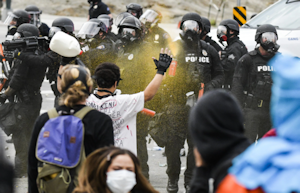3-20-21 NY Times Report: Widespread Failure in Policing Nationwide



In City After City, Police Mishandled Black Lives Matter Protests
By Kim Barker, Mike Baker and Ali Watkins
Inquiries into law enforcement’s handling of the George Floyd protests last
summer found insufficient training and militarized responses — a widespread
failure in policing nationwide.
For many long weeks last summer, protesters in American cities faced off against
their own police forces in what proved to be, for major law enforcement agencies
across the country, a startling display of violence and disarray.
In Philadelphia, police sprayed
tear gas on a crowd of mainly peaceful protesters trapped on an
interstate who had nowhere to go and no way to breathe. In Chicago, officers
were given arrest kits so old that the plastic handcuffs were decayed or broken.
Los Angeles officers were issued highly technical foam-projectile launchers for
crowd control, but many of them had only two hours of training; one of
the projectiles
bloodied the eye of a homeless man in a wheelchair. Nationally,
at least eight people were blinded after being hit with police projectiles.
Now, months after the demonstrations that followed the killing of George Floyd
by the Minneapolis police in May, the full scope of the country’s policing
response is becoming clearer. More than a dozen after-action evaluations have
been completed, looking at how police departments responded to the
demonstrations — some of them chaotic and violent, most peaceful — that
broke out
in hundreds of cities between late May and the end of August.
&uuid=(email)) In
city after city, the reports are a damning indictment of police forces that were
poorly trained, heavily militarized and stunningly unprepared for the
possibility that large numbers of people would surge into the streets, moved
by the graphic images of Mr. Floyd’s death under a police officer’s knee.
In
city after city, the reports are a damning indictment of police forces that were
poorly trained, heavily militarized and stunningly unprepared for the
possibility that large numbers of people would surge into the streets, moved
by the graphic images of Mr. Floyd’s death under a police officer’s knee.
The mistakes transcended geography,
staffing levels and financial resources. From midsize departments like the one
in Indianapolis to big-city forces
like New York City’s, from top commanders to officers on the beat, police
officers nationwide were unprepared to calm the summer’s unrest, and their
approaches consistently did the opposite. In many ways, the problems highlighted
in the reports are fundamental to modern American policing, a demonstration
of the aggressive tactics that had infuriated many of the protesters to begin
with.
The New York Times reviewed reports by outside investigators, watchdogs and
consultants analyzing the police response to protests in nine major cities,
including four of the nation’s largest. The Times also reviewed after-action
examinations by police departments in five other major cities. Reports in some
cities, such as
Oakland and Seattle, are not yet completed. In Minneapolis, the city that
sparked a national reckoning over policing, the City Council only agreed
last month to hire a risk-management company to analyze the city’s response
to the protests, despite months of pressure.
Almost uniformly, the reports said departments need more training in how to
handle large protests. They also offered a range of recommendations to improve
outcomes in the future: Departments need to better work with community
organizers, including enlisting activists to participate in trainings or
consulting with civil rights attorneys on protest-management policies. Leaders
need to develop more restrictive guidelines and better supervision of crowd
control munitions, such as tear gas. Officers need more training to manage their
emotions and aggressions as part of de-escalation strategies.
Those first days of protest after Mr. Floyd’s killing presented an extraordinary
law enforcement challenge, experts say, one that few departments were prepared
to tackle. Demonstrations were large, constant and unpredictable, often
springing up organically in several neighborhoods at once. While the vast
majority of protests were peaceful, in cities like
New York,
Philadelphia,
Minneapolis and
Portland,
buildings were looted and
fires were set, and demonstrators
hurled firecrackers and
Molotov cocktails at law enforcement officers. At least
six people were killed; hundreds were injured; thousands were arrested.
Reviewers more often found that officers behaved aggressively, wearing riot gear
and spraying tear gas or “less-lethal” projectiles in indiscriminate ways,
appearing to target peaceful demonstrators and displaying little effort to
de-escalate tensions. In places like Indianapolis and Philadelphia,
reviewers found, the actions of the officers seemed to make things worse.
Several reports faulted departments for failing to train officers to de-escalate
conflict, control crowds and arrest large numbers of people. In Raleigh, N.C.,
officers said they were supposed to be trained to manage crowds annually, but
those trainings were often canceled. Most Portland police officers had not
received “any recent skills training in crowd management, de-escalation,
procedural justice, crisis prevention, or other critical skills for preventing
or minimizing the use of force,” the city’s report found.
nytimes.com --- Subscription required for full article